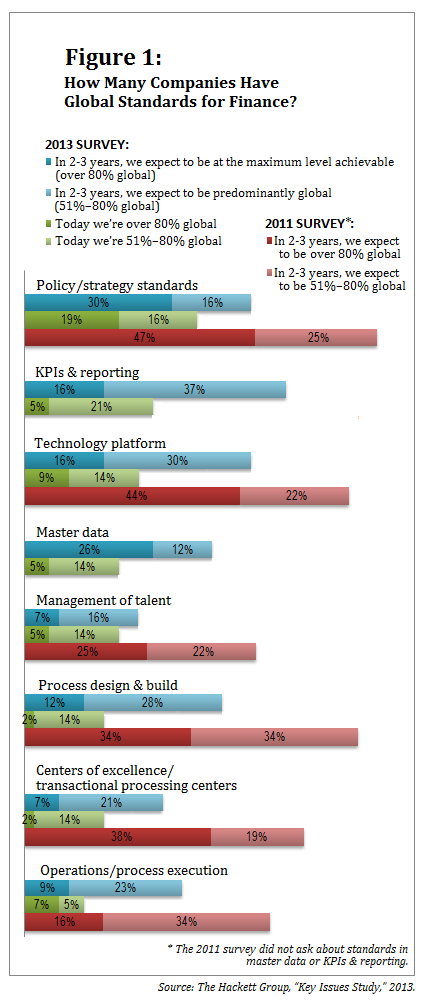 Last week, The Hackett Group released a report aptly titled “Transforming the Finance Organization: Ambition vs. Reality.” It combines the results of two Hackett research projects and reaches the conclusion that finance teams have been biting off more than they can chew when it comes to transformational projects. However, Hackett also finds that finance executives' change agenda in 2013 was considerably more modest than it was a couple years prior—suggesting that ambition in the finance function may be starting to align more closely with reality.
Last week, The Hackett Group released a report aptly titled “Transforming the Finance Organization: Ambition vs. Reality.” It combines the results of two Hackett research projects and reaches the conclusion that finance teams have been biting off more than they can chew when it comes to transformational projects. However, Hackett also finds that finance executives' change agenda in 2013 was considerably more modest than it was a couple years prior—suggesting that ambition in the finance function may be starting to align more closely with reality.
In its 2013 “Key Issues Study,” Hackett asked finance executives in a wide range of companies whether their organization has global standards in eight areas: technology infrastructure, key performance indicators (KPIs) and reporting, talent management, master data, centers of excellence/transaction processing centers, setting policies and strategies, designing and building processes, and operations/process execution. See Figure 1, below.
In each of these areas, respondents were asked to pick the category of global standardization that best describes their organization's current state and the category that they expect to reach in the next two to three years. Many respondents selected one category to describe their company's current state (e.g., “predominantly global—51% to 80%”) and picked the next category up to describe where they expect to be in a few years (e.g., “maximum global level achievable—more than 80%”). The category with the most respondents reporting that their organization already has global standards was “policy/strategy standards”—19 percent said they're at the maximum level achievable, and 16 percent said they're predominantly global. These numbers are strong, yet 30 percent of respondents expect to reach the maximum level within three years, while 16 percent expect to be predominantly global at that time. If these projects are successful, the proportion of companies at the maximum achievable level of globalization in policy/strategy standards would increase by more than 50 percent in just a few years.
The question is: How likely are they to be successful? “The reality is that over the past two years, the data from our annual 'Key Issues Study' show no measurable increase in the level of global standards across business services,” last week's Hackett report states. Lynne Schneider, senior research director with Hackett and one of the report's authors, puts it this way: “Across the board, people are optimistic about how much change they can execute in the next two to three years, relative to what they did in the past two to three years. I think the difference may be ambition versus reality.”
Comparing the data from Hackett's latest “Key Issues Study” with the 2011 version of the same survey brings the challenge into stark focus. Look at how respondents' 2011 projections of where they expect to be in two to three years (the red lines on Figure 1) compare with the 2013 reality (the green lines). For example, organizations may be more advanced in global policy/strategy standards than in other areas, but three years ago 47 percent of companies expected to be at the maximum achievable level of global standardization by now, and only 19 percent have actually reached that goal.
Perhaps because so many companies failed to achieve their goals from a few years ago, comparing finance's 2011 expectations (the red lines) with the expectations for two to three years from now (the blue lines) reveals a serious reduction in ambition. A quarter of 2011 respondents expected their talent management to be at the maximum possible level of globalization by now. Yet only 5 percent of companies actually reached that goal—and only 7 percent now think they'll be there by 2016.
“I think that finance people have realized that getting to this level of global standard is more difficult than they initially thought,” Schneider says. “The benefit of hindsight is that they can see that they set goals that were unreachable with the resources that they had, and now they are trying to do a better job of setting goals for standardization that are more readily achievable. The difference between where they are today and where they want to be in a few years is still significant, but they are probably being more realistic about the amount of improvement they will be able to make.”

The report released last week also considers results of a separate Hackett study, conducted in 2012, that explored which finance processes companies have been working to transform, and which they expect to tackle in the near future. In that survey, Hackett divided respondents into two performance categories based on the cost of their finance function, its degree of standardization, and indicators of the quality of its outputs. Top performers accounted for around 20 to 25 percent of the participants, and Hackett grouped the rest of the organizations into a “peer group.”
Half of all top performers reported that they had comprehensively transformed their compliance management practices from 2010 to 2012, while 40 percent had engaged in comprehensive transformation of their planning and performance management processes, and the same proportion had transformed “service, process improvement, and function management.” In contrast, only 19 percent of the peer group had completed comprehensive transformations of compliance management or of service, process improvement, and function management—and only 12 percent had transformed planning and performance management.
The areas in which the most peer-group companies had achieved comprehensive transformation were cash disbursements (27 percent) and tax management (23 percent). More than half (58 percent) of the peer group had achieved either moderate or comprehensive transformation of their general accounting and external reporting processes.
Looking forward, companies in both performance categories said they expect to do a better job of transforming their finance processes over the next two to three years. Half of all top performers, and 42 percent of the peer group, plan to complete a comprehensive transformation of planning and performance management/business analysis. (See Figure 2.) Those proportions are much higher than the 40 percent of top performers and 12 percent of the peer group that had achieved comprehensive transformation in that area in the recent past.
Although history suggests that companies tend to be overly optimistic about their ability to transform critical processes and achieve global standardization, many now seem to be making internal changes that improve their chances of succeeding with their transformational goals over the next few years. Schneider says she's seeing an increasing number of companies dedicating resources to transformational projects. “We have seen a renewed focus on internal transformation groups. It's our hope that these groups don't get their attention subdivided into 15 different high-priority projects that all must be done right now,” she says.
“More and more companies are making investments to put in place the right infrastructure to carry out these projects,” adds Tom Willman, an associate principal and global practice leader, finance executive advisory program, for Hackett and Schneider's co-author on the report. “Are companies going to be more successful than they have been in the past? I think the key is: Are they going to adequately prioritize the things they want to accomplish and dedicate the appropriate resources to those activities? If yes, then they are positioned to make some meaningful progress. You have to prioritize what is most important from a strategic standpoint and what is most important from a financial standpoint, then allocate resources and set expectations appropriately against those priorities.”
© Touchpoint Markets, All Rights Reserved. Request academic re-use from www.copyright.com. All other uses, submit a request to [email protected]. For more inforrmation visit Asset & Logo Licensing.



